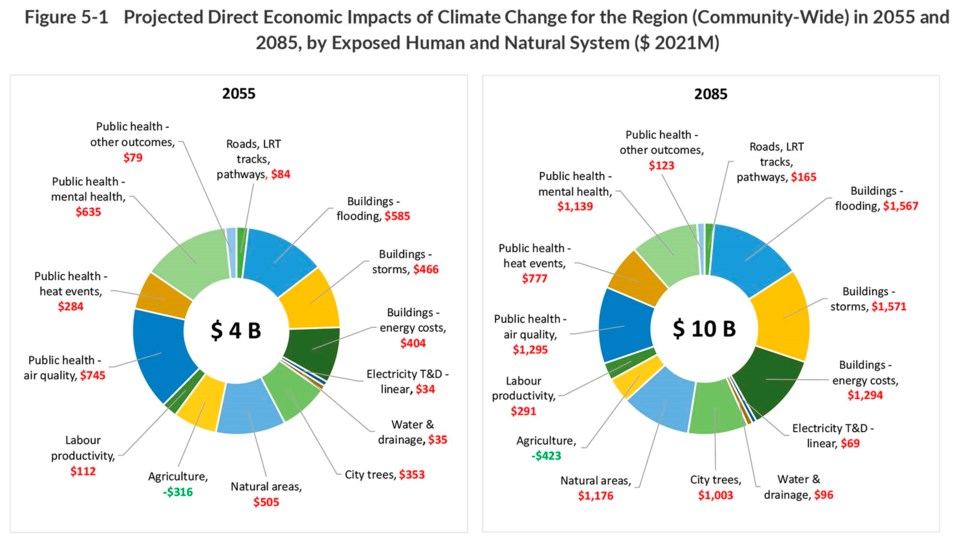The Edmonton region could lose $4 billion a year by the 2050s if it fails to act on global heating, a new regional report has found, but could prevent all those losses for just $5,700 per person.
The Edmonton Metropolitan Region Board (EMRB) accepted the EMRB Climate Resilience Study at its Dec. 14 meeting. The study looks at the potential costs of global heating in the capital region and what steps it should take to minimize such costs.
This report came out of a motion from then-Edmonton mayor Don Iveson to examine how global heating will affect the capital region, St. Albert Mayor Cathy Heron said in an interview.
“Weather doesn’t see boundaries,” she said, and smoke from wildfires in Sturgeon County can foul the air in St. Albert.
Global heating presents unique risks to every community, but Heron said the region can save money by working together to address them.
Huge health costs
The report used climate and economic models, and regional experts to estimate the costs global heating would impose on the Edmonton region by 2050 under a worst-case, high warming scenario.
The report projected the Edmonton region’s mean winter temperature would rise 4.1 C by the 2050s, with the number of very hot (+30 C) days rising to 11 from 1. This would result in longer summers, shorter winters, more extreme weather, less water in the North Saskatchewan River (the source of St. Albert’s drinking water) in the summer, and more risk of wildfires and smoke.
The report found these and other changes would likely cause the region to lose $4 billion a year by 2055, rising to $10 billion by 2085. The actual costs would likely be higher, as these estimates did not include the cost of service disruptions and compounding effects (such as simultaneous extreme heat, drought, and wildfire).
Some 44 per cent of these costs (about $1.75 billion) would be due to health impacts from excessive heat and wildfire smoke, the report found. Some $405 million of them would be the result of greater cooling needs, while another $585 million would be caused by floods. The report found farmers might earn $315 million a year more under global heating, but only if the region made significant investments to protect against the droughts and invasive pests brought by global heating.
Prevention pays
The report set out 24 actions the region should take to reduce the cost of global heating. These included regional plans to reduce wildfire risks, regional building standards for extreme heat and poor air quality, and public education on how to prepare for climate emergencies.
The report found that every dollar the region invested in climate action today could save it $2 to $6 in climate costs by 2050. Investing $9.3 billion in the next 10 years ($5,700 per person) could prevent $19 billion to $54 billion in damages.
“The business case for adaptation is robust,” the report found, with actions to increase climate resilience typically providing benefits that far exceed their costs.
Report co-author Richard Boyd told EMRB members they should create a climate adaptation plan with specific targets, timelines, and resources, ramp up current climate action, and inform residents of the economic case for action.
Sturgeon County Mayor Alanna Hnatiw said this report sends a clear message about the need to build climate resilience into our communities.
“This is an opportunity for us to get higher standards for indoor air quality,” she said, noting the region had “missed the boat” on indoor air quality during the COVID-19 pandemic. (Many of the same air quality measures that guard against COVID, such as masks and better filters, can also protect against wildfire smoke.)
Heron said it’s often tough to convince people of the need for climate action because of the cost. Still, she said the climate disasters of the last couple of years have made the cost of inaction obvious.
“If you look down south in Alberta, they have no water,” she said, referring to this year’s drought, and those shortages will soon come to this region.
Heron said St. Albert has done its own climate risk assessment and adopted a 1:200 year floodplain standard to address global heating, but still needs to do much more. She said she will press the EMRB to set regional carbon emission reduction targets and to act on climate adaptation.
The climate resilience report is available at emrb.civicweb.net/document/27018.



